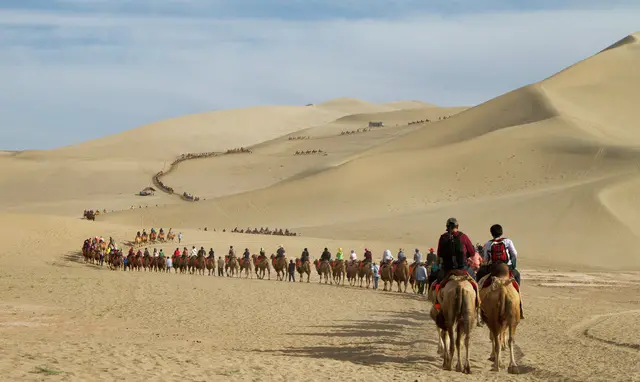In Iran, the small northern town of Ardebil may not have the allure of top tourist attractions like Isfahan or Shiraz, but year after year culture-sensitive visitors still flock there to see a famed collection of ancient Chinese blue-and-white porcelain.
Displayed at the mausoleum of Sheikh Safi-din, a world cultural heritage site, the dozens of porcelain pieces dating back to the 13th century, always mesmerize visitors with the beauty of plants and animals vividly painted in blue against white china.
"All these treasures came from ancient China," a local tour guide known as Fardin repeats these words cheerfully every day as he shows visitors around the place.
"When I was small, it was something to be proud of to have a piece of genuine Chinese porcelain in one's home."
But what Fardin might not know is that these porcelain pieces were actually the joint work of ancient Iran and China that sat on the two ends of the thriving old Silk Road, as new research found that the blue paint applied on the wares was probably imported from Persia to ancient China, giving the objects a distinct look that Chinese workshops never successfully duplicated at the time.
According to Persian annals, part of the Chinese porcelain collection at the mausoleum was imported from China via the Silk Road, while other pieces were gifts to Persian dignitaries from Chinese emperors.
"Bestowing such valuable gifts on us shows that China and Iran have long been friends," Fardin said, noting such exchanges enriched both the Chinese and Persian cultures.
Silk Road legacy lives on
The legacy of Silk Road route remains alive with Iranian businessmen.
Like his ancestors, Hussein Hosseiny travels regularly to China to sell Persian carpets, but the difference is he doesn't have to literally trek down the Silk Road.
For him, the centuries-old route is still as vibrant and profitable as before, as prized Persian silk carpets never fail to satisfy Chinese customers generation after generation.
Sadeq Zibakalam, a professor at the Tehran University, said everybody in Iran knows about the Silk Road and that ancient Persia and China were two hubs of the trade route.
Now, China and Iran aspire to revive the camel-trodden, garrison-guarded dirt trails of the Silk Road that vanished long ago in a modern context, and have promised to deepened cooperation.
The sprawling subway network underneath the Iranian capital Tehran is a vivid example of increased bilateral infrastructure collaboration between the two sides.
First built in 1999, the subway system now operates five lines and will have two new lines added.
The subway system, for which the Iranians built the infrastructure and the Chinese supplied the trains and the operation system, has benefited millions of Iranians getting about in the metropolitan notorious for its traffic congestions.
With a one-way ticket costing as little as 5,000 rial (0.17 U.S. dollars), the subway is a major means of transportation for low-income citizens.
Belt & Road resonates with middle east
Today, Tehran is just one of many places along the ancient Silk Road where the Chinese is paving rail. The China-proposed Belt and Road Initiative has spawned an infrastructure boom in the region.
In Turkey, an ambitious high-speed railway project is underway to connect Asia and Europe through the Bosporus Strait.
Mustafa Babal, a senior engineer overseeing the high-speed railway project, told Xinhua five railway lines are being built, four of which connect the Turkish capital Ankara and other Turkish cities, while one links Ankara with neighboring Georgia.
The railways, which are designed to allow trains to travel at 350 km per hour, are part of a joint project by the Chinese and Turkish railway administrations.
Babal notes the line between Ankara and Istanbul will be extended to the border with Bulgaria to help connect Beijing and London.
Babal estimates the line will have a transportation value of 75 billion U.S. dollars, replacing the current intercontinental railway, which is longer, as the top choice for cargos moving between the two continents.
As "a significant project for the world", the railway also has tremendous political value, Babal said.
The Silk Road, which brought prosperity to the region, has been cherished for centuries for its spirit of sharing and mutual benefit, said Xue Qingguo, a Middle East expert at the Beijing Foreign Studies University.
He told Xinhua that most Middle East countries have fond memories of the Silk Road which is reminiscent of friendly exchanges and booming trade.
Xue said such a positive legacy is indeed needed by the region, many parts of which is now troubled by turmoil.
Wu Sike, China's former special envoy on Middle East affairs, told Xinhua that Middle East countries in general have responded positively to the Belt and Road Initiative thanks to their favorable experience with the Silk Road as well as political mutual trust and economic complementarity with China.
"So when we raised the initiative, it soon resonated with them, " he said.
 简体中文
简体中文

